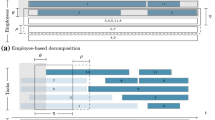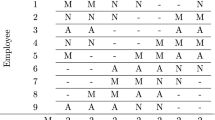Abstract
This paper studies a two-phase decomposition approach to solving the personnel scheduling problem. The first phase creates a days-off-schedule, indicating working days and days off for each employee. The second phase assigns shifts to the working days in the days-off-schedule. This decomposition is motivated by the fact that personnel scheduling constraints are often divided into two categories: one specifies constraints on working days and days off, while the other specifies constraints on shift assignments. To assess the consequences of the decomposition approach, we apply it to public benchmark instances, and compare this to solving the personnel scheduling problem directly. In all steps we use mathematical programming. We also study the extension that includes night shifts in the first phase of the decomposition. We present a detailed results analysis, and analyze the effect of various instance parameters on the decompositions’ results. In general, we observe that the decompositions significantly reduce the computation time, but the quality, though often good, depends strongly on the instance at hand. Our analysis identifies which aspects in the instance can jeopardize the quality.
Similar content being viewed by others
Notes
For MER a lower bound of 7,079 was established.
References
Abdennadher, S., Schlenker, H. (1999). Nurse scheduling using constraint logic programming. In Proceedings of the 1998 Winter Simulation Conference Proceedings (pp. 838–843).
Azaiez, M. N., & Al Sharif, S. S. (2005). A 0–1 goal programming model for nurse scheduling. Computers & Operations Research, 32(3), 491–507.
Baxter, J., & Mosby, M. (1988). Generating acceptable shift-working schedules. The Journal of the Operational Research Society, 39(6), 537–542.
Brucker, P., Burke, E., Curtois, T., Qu, R., & Vanden Berghe, G. (2010). A shift sequence based approach for nurse scheduling and a new benchmark dataset. Journal of Heuristics, 16(4), 559–573.
Burke, E. K., & Curtois, T. (2014). New approaches to nurse rostering benchmark instances. European Journal of Operational Research, 237(1), 71–81.
Burke, E. K., de Causmaecker, P., van Landeghem, H., & vanden Berghe, G. (2004). The state of the art of nurse rostering. Journal of Scheduling, 7(6), 441–499.
Cheang, B., Li, H., Lim, A., & Rodrigues, B. (2003). Nurse rostering problems-a bibliographic survey. European Journal of Operational Research, 151(3), 447–460.
Curtois, T. (2007). Employee scheduling benchmark data sets. http://www.cs.nott.ac.uk/~tec/NRP/. Accessed June 2014.
Day, P. R., & Ryan, D. M. (1997). Flight attendant rostering for short-haul airline operations. Operations Research, 45(5), 649–661.
Ernst, A., Jiang, H., Krishnamoorthy, M., Owens, B., & Sier, D. (2004). An annotated bibliography of personnel scheduling and rostering. Annals of Operations Research, 127(1), 21–144.
Gärtner, J., Musliu, N., & Slany, W. (2001). Rota: A research project on algorithms for workforce scheduling and shift design optimization. AI Communications, 14(2), 83–92.
Glass, C. A., & Knight, R. A. (2010). The nurse rostering problem: A critical appraisal of the problem structure. European Journal of Operational Research, 202(2), 379–389.
Ikegami, A., & Niwa, A. (2003). A subproblem-centric model and approach to the nurse scheduling problem. Mathematical Programming, 97(3), 517–541.
Maenhout, B., & Vanhoucke, M. (2010). Branching strategies in a branch-and-price approach for a multiple objective nurse scheduling problem. Journal of Scheduling, 13(1), 77–93.
Mason, A., Smith, M. (1998). A nested column generator for solving rostering problems with integer programming. In Proceedings of International Conference on Optimisation: Techniques and Applications (pp. 827–834).
Millar, H., & Kiragu, M. (1998). Cyclic and non-cyclic scheduling of 12 h shift nurses by network programming. European Journal of Operational Research, 104(3), 582–592.
Nurmi, K., Kyngäs, J., & Post, G. (2011). Driver rostering for bus transit companies. Engineering Letters, 19(2), 125–132.
Parr, D., & Thompson, J. (2007). Solving the multi-objective nurse scheduling problem with a weighted cost function. Annals of Operations Research, 155(1), 279–288.
Santos, H.G., Toffolo, T., Ribas, S., Gomes, R. (2012). Integer programming techniques for the nurse rostering problem. In Proceedings of the 9th International Conference on the Practice and Theory of Automated Timetabling (pp. 257–283).
Valouxis, C., Gogos, C., Goulas, G., Alefragis, P., & Housos, E. (2012). A systematic two phase approach for the nurse rostering problem. European Journal of Operational Research, 219(2), 425–433.
Van den Bergh, J., Beliën, J., De Bruecker, P., Demeulemeester, E., & De Boeck, L. (2013). Personnel scheduling: A literature review. European Journal of Operational Research, 226(3), 367–385.
Van Veldhoven, S. (2011). Days off personnel scheduling. Master’s thesis, University of Twente, The Netherlands.
Author information
Authors and Affiliations
Corresponding author
Rights and permissions
About this article
Cite this article
van Veldhoven, S., Post, G., van der Veen, E. et al. An assessment of a days off decomposition approach to personnel shift scheduling. Ann Oper Res 239, 207–223 (2016). https://doi.org/10.1007/s10479-014-1674-7
Published:
Issue Date:
DOI: https://doi.org/10.1007/s10479-014-1674-7




